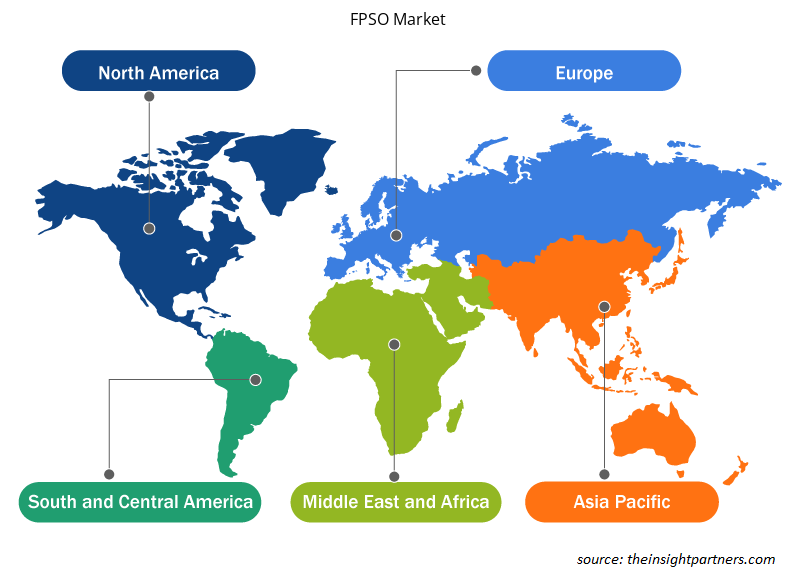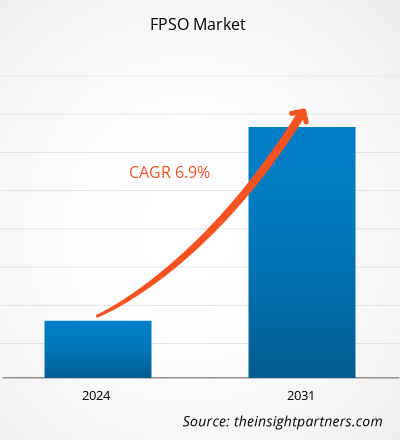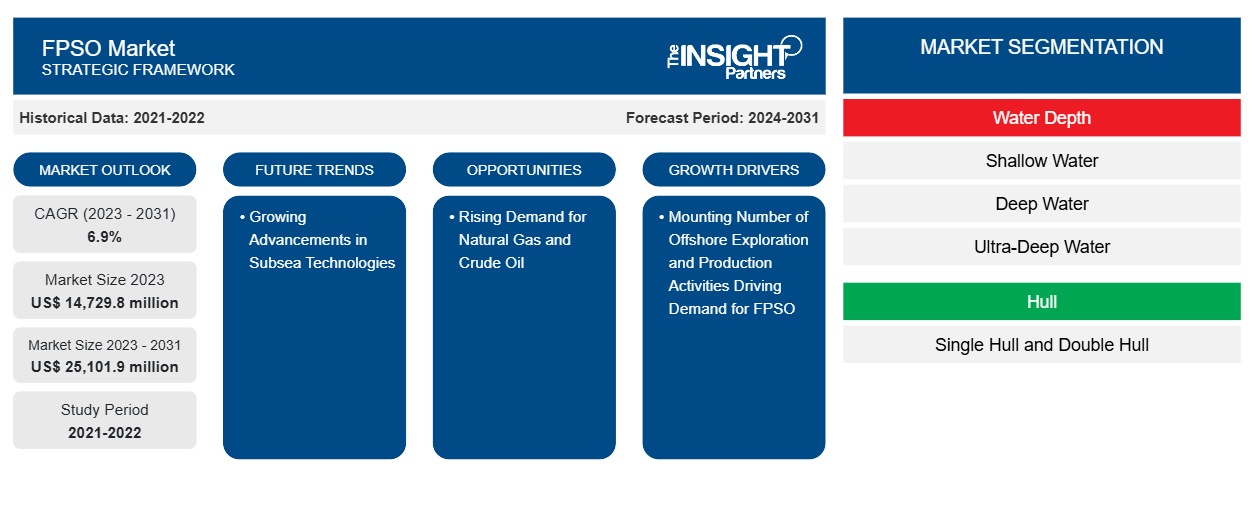Se proyecta que el tamaño del mercado de FPSO alcance los 25.101,9 millones de dólares estadounidenses en 2031, frente a los 14.729,8 millones de dólares estadounidenses en 2023. Se espera que el mercado registre una CAGR del 6,9 % entre 2023 y 2031. El creciente desarrollo del sector del petróleo y el gas y el aumento de las actividades de exploración de petróleo y gas son otras tendencias para el mercado de FPSO.
Análisis del mercado de FPSO
La creciente expansión de los proyectos de petróleo y gas es el factor clave que estimula la demanda de FPSO. Se prevé que la demanda de FPSO, especialmente en alta mar, junto con un precio del petróleo moderadamente estable y un aumento en las actividades de exploración y producción de petróleo en alta mar, impulsen un fuerte crecimiento de la demanda mundial de buques FPSO en los próximos cinco años. Algunas de las principales empresas de FPSO, como Total Energies, Petrobras, CNOOC Ltd, Equinor ASA y Exxon Mobil, entre otras, se están centrando en impulsar el desarrollo del mercado de FPSO.
Descripción general del mercado de FPSO
Las empresas de exploración de petróleo y gas, como Equinor ASA, se están concentrando en actividades de exploración de petróleo y gas en aguas profundas y ultraprofundas. Por ejemplo, en 2022, Shell inició un proyecto de producción de petróleo en el campo PowerNap. Además, las empresas de petróleo y gas están implementando tecnologías novedosas debido a los avances en tecnologías offshore, como torretas separables, diseños de casco cilíndrico y diseños de doble casco. Además, los avances tecnológicos en FPSO sobre otros sistemas de producción, como la digitalización de FPSO y la penetración de la automatización y mucho más en la industria del petróleo y el gas, aumentan el enfoque de las empresas del mercado en las actividades de I+D y el desarrollo de nuevos productos generaría tendencias para el crecimiento del mercado de FPSO en los próximos años.
Personalice este informe según sus necesidades
Obtendrá personalización en cualquier informe, sin cargo, incluidas partes de este informe o análisis a nivel de país, paquete de datos de Excel, así como también grandes ofertas y descuentos para empresas emergentes y universidades.
-
Obtenga las principales tendencias clave del mercado de este informe.Esta muestra GRATUITA incluirá análisis de datos, desde tendencias del mercado hasta estimaciones y pronósticos.
Factores impulsores y oportunidades del mercado de FPSO
El creciente número de actividades de exploración y producción en alta mar impulsa la demanda de FPSO
En las últimas décadas, la exploración y producción de petróleo y gas en alta mar se ha intensificado sustancialmente. Además, los descubrimientos de nuevas reservas de petróleo y gas están aumentando exponencialmente en todo el mundo. La creciente presencia de importantes empresas de extracción de petróleo y gas, como Petrobras, en las actividades de exploración y producción en alta mar. En Petrobras, la mayoría de las reservas de petróleo se encuentran en campos offshore, lo que ha dirigido las actividades de perforación. Además, según la AIE, para 2040, los gastos de capital anuales para las actividades de producción de petróleo y gas en alta mar en Brasil ascenderían a 60.000 millones de dólares. Además, el creciente número de explotaciones de reservas marginales de petróleo en zonas remotas en alta mar, junto con la flexibilidad de las FPSO para operar sin el apoyo de una estructura fija, impulsa el crecimiento del mercado.Petrobras, in offshore exploration and production activities. In Petrobras, most of the oil reserves are in offshore fields, which has directed the drilling activities. In addition, according to the IEA, by 2040, annual capital expenses for offshore oil and exploitations of marginal oil reserves in remote offshore areas, along with the flexibility of FPSOs to operate without the support of a fixed structure, boosts market growth.
Demanda creciente de gas natural y petróleo crudo: una oportunidad en el mercado de FPSO
La creciente demanda de petróleo crudo y gas natural aumenta constantemente, lo que es una de las principales razones detrás del crecimiento del mercado de FPSO. Se proyecta que la demanda de petróleo experimente una tendencia al alza durante 2022-2025 en los países de la OCDE, según la OPEP. Sin embargo, se anticipa que la demanda en los países no pertenecientes a la OCDE aumentará en 22,5 mb/día durante el período de pronóstico hasta 2045. El informe de la OPEP identificó que se anticipa que el gas natural sea el combustible fósil de más rápido crecimiento y sería el segundo mayor contribuyente a la combinación energética, que se proyecta que tendrá una participación de ~25% en 2045. En los próximos años, se anticipa que Asia Pacífico sea testigo de una alta demanda de gas natural debido al creciente uso de gas natural en diversos sectores industriales. Por lo tanto, se anticipa que la creciente demanda de gas natural y petróleo crudo a nivel mundial ofrecerá oportunidades valiosas para el crecimiento del mercado de FPSO en los próximos años.
Análisis de segmentación del informe de mercado de FPSO
Los segmentos clave que contribuyeron a la derivación del análisis del mercado FPSO son la profundidad del agua, el casco, el amarre y la construcción.
- Según la profundidad del agua, el mercado de FPSO se ha dividido en aguas poco profundas, aguas profundas y aguas ultraprofundas. El segmento de aguas poco profundas tuvo una mayor participación de mercado en 2023.
- En función del casco, el mercado de FPSO se ha dividido en monocasco y doble casco. El segmento de doble casco tuvo una mayor participación de mercado en 2023.
- En función del tipo de amarre, el mercado de FPSO se ha dividido en amarre abierto y amarre desconectable. El segmento de amarre abierto tuvo una mayor participación de mercado en 2023.
- En función de la construcción, el mercado de FPSO se ha dividido en nuevos y reconvertidos. El segmento de nuevos y reconvertidos tuvo una mayor participación de mercado en 2023.
Análisis de la cuota de mercado de FPSO por geografía
El alcance geográfico del informe del mercado FPSO se divide principalmente en cinco regiones: América del Norte, Asia Pacífico, Europa, Medio Oriente y África, y América del Sur/América del Sur y Central.
La región de Sudamérica incluye Brasil, Argentina y el resto de la región de Sudamérica. El resto de la región de Sudamérica incluye a Chile, Colombia, Guatemala y Perú. Los avances tecnológicos han tenido un fuerte impacto en la economía de Brasil y Argentina, lo que ha contribuido a su avance en gran medida. La aplicación del petróleo en Sudamérica ha disminuido gradualmente en los últimos tres años. Sin embargo, con la recuperación de la extracción de petróleo crudo, es probable que la situación cambie y las empresas ahora se están centrando en más actividades de exploración y producción de petróleo y gas, lo que está impulsando la demanda del mercado de FPSO en Sudamérica.
Perspectivas regionales del mercado de FPSO
Los analistas de Insight Partners explicaron en detalle las tendencias y los factores regionales que influyen en el mercado de FPSO durante el período de pronóstico. Esta sección también analiza los segmentos y la geografía del mercado de FPSO en América del Norte, Europa, Asia Pacífico, Oriente Medio y África, y América del Sur y Central.

- Obtenga datos regionales específicos para el mercado FPSO
Alcance del informe de mercado de FPSO
| Atributo del informe | Detalles |
|---|---|
| Tamaño del mercado en 2023 | US$ 14.729,8 millones |
| Tamaño del mercado en 2031 | US$ 25.101,9 millones |
| CAGR global (2023 - 2031) | 6,9% |
| Datos históricos | 2021-2022 |
| Período de pronóstico | 2024-2031 |
| Segmentos cubiertos |
Por profundidad del agua
|
| Regiones y países cubiertos |
América del norte
|
| Líderes del mercado y perfiles de empresas clave |
|
Densidad de actores del mercado: comprensión de su impacto en la dinámica empresarial
El mercado de FPSO está creciendo rápidamente, impulsado por la creciente demanda de los usuarios finales debido a factores como la evolución de las preferencias de los consumidores, los avances tecnológicos y una mayor conciencia de los beneficios del producto. A medida que aumenta la demanda, las empresas amplían sus ofertas, innovan para satisfacer las necesidades de los consumidores y aprovechan las tendencias emergentes, lo que impulsa aún más el crecimiento del mercado.
La densidad de actores del mercado se refiere a la distribución de las empresas o firmas que operan dentro de un mercado o industria en particular. Indica cuántos competidores (actores del mercado) están presentes en un espacio de mercado determinado en relación con su tamaño o valor total de mercado.
Las principales empresas que operan en el mercado FPSO son:
- MODEC, Inc.
- Petróleo Brasileiro SA
- Bumi Armada Berhad
- SBM Offshore NV
- CNOOC limitada
- TotalEnergies SE
Descargo de responsabilidad : Las empresas enumeradas anteriormente no están clasificadas en ningún orden particular.

- Obtenga una descripción general de los principales actores clave del mercado FPSO
Noticias y desarrollos recientes del mercado de FPSO
El mercado de FPSO se evalúa mediante la recopilación de datos cualitativos y cuantitativos a partir de investigaciones primarias y secundarias, que incluyen publicaciones corporativas importantes, datos de asociaciones y bases de datos. A continuación, se incluye una lista de los avances en el mercado en materia de innovaciones, expansión comercial y estrategias:
- En mayo de 2023, MODEC, Inc. anunció que procederá con la ingeniería, adquisición y construcción del buque flotante de producción, almacenamiento y descarga Uaru para el proyecto Uaru de ExxonMobil Guyana. (Fuente: MODEC, Inc., comunicado de prensa/sitio web de la empresa/boletín informativo)
- En abril de 2024, ExxonMobil realizó una inversión final para el desarrollo de Whiptail en alta mar en Guyana, después de obtener las aprobaciones gubernamentales y regulatorias requeridas. (Fuente: ExxonMobil Corporation, comunicado de prensa/sitio web de la empresa/boletín informativo)
Informe de mercado de FPSO: cobertura y resultados
El informe “Tamaño y pronóstico del mercado de FPSO (2021-2031)” proporciona un análisis detallado del mercado que cubre las siguientes áreas:
- Tamaño del mercado de FPSO y pronóstico a nivel global, regional y nacional para todos los segmentos clave del mercado cubiertos bajo el alcance
- Dinámica del mercado, como impulsores, restricciones y oportunidades clave
- Tendencias del mercado de FPSO
- Análisis PEST y FODA detallados
- Análisis del mercado de FPSO que cubre las tendencias clave del mercado, el marco global y regional, los principales actores, las regulaciones y los desarrollos recientes del mercado
- Análisis de la industria, el panorama y la competencia de los FPSO, que abarca la concentración del mercado, el análisis de mapas de calor, los actores destacados y los desarrollos recientes
- Perfiles detallados de empresas
- Análisis histórico (2 años), año base, pronóstico (7 años) con CAGR
- Análisis PEST y FODA
- Tamaño del mercado, valor/volumen: global, regional y nacional
- Industria y panorama competitivo
- Conjunto de datos de Excel
Informes recientes
Testimonios
Razón para comprar
- Toma de decisiones informada
- Comprensión de la dinámica del mercado
- Análisis competitivo
- Información sobre clientes
- Pronósticos del mercado
- Mitigación de riesgos
- Planificación estratégica
- Justificación de la inversión
- Identificación de mercados emergentes
- Mejora de las estrategias de marketing
- Impulso de la eficiencia operativa
- Alineación con las tendencias regulatorias























 Obtenga una muestra gratuita para - Mercado de FPSO
Obtenga una muestra gratuita para - Mercado de FPSO